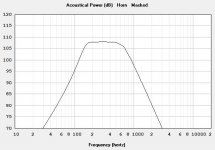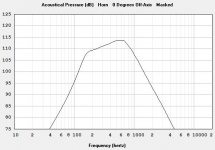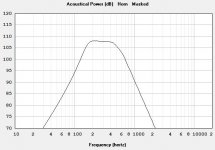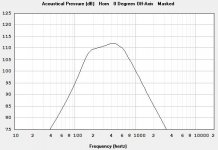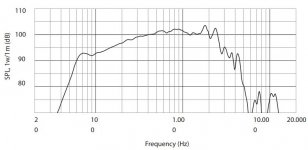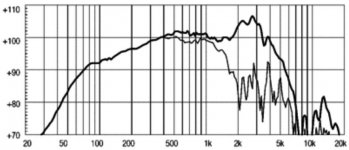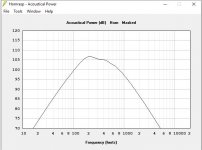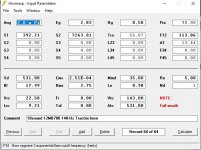I'm scratching my head when comparing power response with on and off-axis response in Hornresp. I understand that a flat power response is desired, but I am afterall listening on-axis. I have attached Hornresp simulations of the 18Sound 12MB700/ 140hz Tractrix horn combination. Should I choose a driver with higher VC inductance and lower BL/Re? Or increase the size of the throat chamber to get a flatter on-axis response?
Not until 40 degrees off-axis does the response begin to approach flat in the intended passband..
Not until 40 degrees off-axis does the response begin to approach flat in the intended passband..
Attachments
You say you want flat power, but the horn you choose has varying directivity. At some point it is more likely you will equalise for flat response. Especially in this region, it is a challenge not to have the power rise with lower frequencies. Maybe more important that it is at least smooth even if not flat.
Hi AllenB, thank you very much for your reply.
I want to use this horn/driver combo 150hz-500hz, and I would ideally like to use a simple passive crossover as discussed in another thread. I have realized that this will be a challenge considering the cone breakup resonances of this driver.
Anyway, I guess a 12dB/oct LP at say 400hz will give me a reasonably flat response in the passband? Also, the midbass tractrix horn will probably be at least 10 degrees off axis, so it may not be an issue..
Perhaps this RCF driver is a better choice?
It has a very strong motor, but a much heavier cone, so a more rolled off HF response..
I want to use this horn/driver combo 150hz-500hz, and I would ideally like to use a simple passive crossover as discussed in another thread. I have realized that this will be a challenge considering the cone breakup resonances of this driver.
Anyway, I guess a 12dB/oct LP at say 400hz will give me a reasonably flat response in the passband? Also, the midbass tractrix horn will probably be at least 10 degrees off axis, so it may not be an issue..
Perhaps this RCF driver is a better choice?
It has a very strong motor, but a much heavier cone, so a more rolled off HF response..
Attachments
The 12" driver has the peak around 2kHz, according to this plot.
If you had to use a notch filter in order to get a proper 6dB or 12dB (whichever you are planning) rolloff, then you would use one because it isn't about the appearance of the circuit, but the acoustic response.
But it seems if you did plan to do 400Hz at 12dB/octave then you'd expect to be down 24dB at 1.6kHz from the crossover alone. If this is achieved in the horn, this is typically far enough. If anything at 2kHz rears its ugly head once you build and measure, just notch it until it takes the downward slope.
If you had to use a notch filter in order to get a proper 6dB or 12dB (whichever you are planning) rolloff, then you would use one because it isn't about the appearance of the circuit, but the acoustic response.
But it seems if you did plan to do 400Hz at 12dB/octave then you'd expect to be down 24dB at 1.6kHz from the crossover alone. If this is achieved in the horn, this is typically far enough. If anything at 2kHz rears its ugly head once you build and measure, just notch it until it takes the downward slope.
Thats quite encouraging Allen, and in addition to the electrical crossover there would also be the the acoustical rolloff as a result of the throat chamber. It has been suggested that this accounts for a 6dB/oct rolloff, but at what frequency does this acoustical rolloff start?
The RCF MB12N405 appears to have much lower cone resonance levels, so I might not need a notch filter at all with this?
Attachments show the FR of the RCF left and 18Sound right.
The RCF MB12N405 appears to have much lower cone resonance levels, so I might not need a notch filter at all with this?
Attachments show the FR of the RCF left and 18Sound right.
Attachments
Last edited:
Breakup peaks are typically stronger at 0 degrees, so an axial plot is going to be misleading. This is especially if you use a front compression chamber. Off axis plots can be useful to determine an average by combining them. If you use a compression chamber you will be taking it somewhat at faith. Use hornresp to estimate, but measure to be sure.
The size (and frequency) can be of your choosing. Sometimes you want to avoid a throat chamber, for higher frequency use for example, replacing it with a phase plug. At lower middle frequencies you can be more arbitrary.
The size (and frequency) can be of your choosing. Sometimes you want to avoid a throat chamber, for higher frequency use for example, replacing it with a phase plug. At lower middle frequencies you can be more arbitrary.
Flat on axis response from a rising on axis horn flare requires little more than a peaking WG, so with a ~2*49/.2 = 490 Hz upper mass corner this one sims flat enough and may blend well enough with the strong break-up modes if the published specs, response is fairly accurate.
GM
GM
Attachments
Flat on axis response from a rising on axis horn flare requires little more than a peaking WG, so with a ~2*49/.2 = 490 Hz upper mass corner this one sims flat enough and may blend well enough with the strong break-up modes if the published specs, response is fairly accurate.
GM
Hi GM, I appreciate your explanation but I'm afraid I'm not at this level of understanding. Would you say the 12MB700 looks like a suitable driver for this horn, despite the cone breakup?
I imported your text file to Hornresp and the simulation is attached below. It doesn't look very nice. Would you care to explain your choices regarding the very large rear chamber and the tiny throat chamber? Using the Hornresp Driver Front Volume calculator, I get about 2 litres so this would be the smallest throat chamber possible without using a phase plug.
I have acquired the tractrix horns, so the dimensions for the horns are set.
Throat 184cm2, Mouth 4850cm2, Length 52,8cm
Attachments
Last edited:
- Status
- This old topic is closed. If you want to reopen this topic, contact a moderator using the "Report Post" button.
- Home
- Loudspeakers
- Multi-Way
- Hornresp power response vs on-axis response
